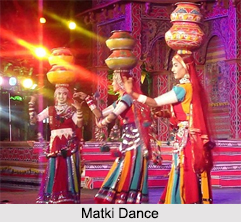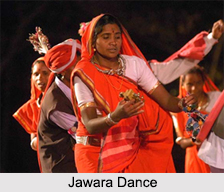 The folk dances of Madhya Pradesh are an essential element of their culture and tradition. Madhya Pradesh not only unifies numerous religions in its part, but is also a home to some of the most famous tribal communities of the country. Actually, the tribal culture in the state is the basis of the integration of a range of folk dance forms to its group of traditional dances.
The folk dances of Madhya Pradesh are an essential element of their culture and tradition. Madhya Pradesh not only unifies numerous religions in its part, but is also a home to some of the most famous tribal communities of the country. Actually, the tribal culture in the state is the basis of the integration of a range of folk dance forms to its group of traditional dances.
Different Folk Dances of Madhya Pradesh
Madhya Pradesh has been, and still is, to a great level dominated by its tribal inhabitants. Following are the different Folk Dances of Madhya Pradesh:
Matki Dance: "Matki" Dance is presented by the women on different occasions. This is a community dance of the "Malwa". The dancers move musically to the beating of a drum that is locally called "Matki".
Karma Dance: Regarded as the oldest of all tribal dances in the state, Karma Dance sees the presentation on the beginning of the spring season. Happily dressed tribal men and women perform this dance, particularly around the trees scattered in the village. Musical instruments like "thumki", "payri", "challa" and" "jhumki" come with the different tribal songs.
Tertali Dance: Tertali Dance is a folk dance of the "Kamar" tribe in Madhya Pradesh. The two or three women of the tribe sit on the land and start the dance performance. Small metal cymbals called `Manjiras` are tied to dissimilar parts of their body.
 Muria Dance: The "Murias" first worship their drums. Regularly they start with a prayer to `Lingo Pen`, the phallic deity of the tribe and the founder of the "Ghotul" society.
Muria Dance: The "Murias" first worship their drums. Regularly they start with a prayer to `Lingo Pen`, the phallic deity of the tribe and the founder of the "Ghotul" society.
Baredi Dance: Baredi dance is presented in the starting of "Diwali" till the day of "Poornima". The dancers perform in a group of brightly dressed 8-10 young men and are choreographed by a head male actor.
Ahiri Dance: Ahiri Dance is a mark of the cattle herders of Gwalior. This dance also has religious connotations. The various communities of Gwalior, who perform this dance, are considered to be the descendants of Lord Krishna.
Lehangi Dance: Lehangi Dance is a well-liked folk dance of the "Banjara" and "Kanjar" tribe of Madhya Pradesh and is performed during the monsoon period. The "Banjara" tribe also performs this dance during the festival of "Rakhi". Young men grasp sticks in their hands and musically beat them while dancing.
Jawara Dance: People of the "Bundelkhand" area perform this dance, to celebrate wealth. Men and women, in colourful costumes dance and celebrate together, synchronizing their movements to a mixture of musical instruments. The women also poise baskets, full of "jawara" on their head.
Phul Pati Dance: This dance is displayed on the time of the festival of "Holi". The girls generally hail from a semi-rural background, slightly than an inclusive rural life style. The Phul Pati Dance performance is restricted to the unmarried girls of Madhya Pradesh.
Grida Dance: The "Grida" dance is performed by the people of Madhya Pradesh when the "Rabi" crop is sown in the region. The sharing is done from different villages of the state. One village acts as the host to the festivity and each village takes turns in hosting the occasion annually.
Naurata Dance: "Naurata" dance is performed by would be brides to pray to the God seeking a good match and marital enjoyment. The nine day festivities during the period of "navaratri" are marked by creating "Naurata" elaborate designs outside the house made from lime and a variety of colours.
Saila Dance: The "Saila" dance is a form of stick dance and is very well-liked amongst the people of "Sarguja", "Baitul" and "Chhindwara" districts. In some of the areas, "Saila" dance is also famous as "Dandar Pate" or "Danda Nach". The dancers generally stand on one foot and hold on the next dancer. Then, they all hop and dance together.




